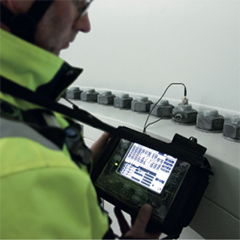Achieving the correct bolt pretension is essential in assuring bolted joint integrity. Bolted joints are critical when ensuring the safe operation of wind turbines or other similar bolted connections. In this context, ultrasonic measurement has proven to be a very accurate and cost-effective solution when installing new bolts, as well as when evaluating existing bolts as part of determining the lifespan of wind turbines. R&D explains why to PES.
In recent years, wind energy has become an important source of electricity production. As with any other technology, wind turbines have a limit to their time in functional operation. Currently, wind turbines are designed to be efficient and reliable for 20 years, with the possibility of extending beyond that.
Continuous inspection of wind turbines is important as it can maximise the turbines’ life expectancy as well as minimise the risk of failure. In this context, the importance of correct bolt pretension is frequently underestimated, as incorrect installation can increase the risk of partial or total failure in wind turbines, since these bolts hold critical components together in the turbine as well as the tower.
A fully tightened bolted joint can sustain millions of load cycles without any problems, whereas a joint consisting of untightened bolts often fails within a few cycles. If a bolt loosens, a chain reaction is likely to occur and, consequently, can result in failure of the entire turbine.
One of the most challenging parts of the tightening process is the correlation between the applied torque and the tension that arises when the nut stretches the bolt a small amount. This tension results in an opposing clamp force that holds the two sections of the joint together. If the clamping force is too low, separation and bolt fatigue may occur. On the other hand, excessive clamping force may produce damage in the joint’s structural components such as excessive distortion or breakage.
By focussing on achieving the correct bolt pretension, you not only ensure a proper clamping force but can also maximise the reliability of the turbine, as well as reduce the need for maintenance and downtime.
An accurate and cost effective solution
In the past, it has been difficult to evaluate bolted joints, since the previously available methods of inspection only focussed on whether the bolts were loose or rusty. However, most joint failures are not caused by the joint design or the fastener. Often, they are the result of insufficient or inconsistent clamp load when assembling the joint.
Problems such as bolt fatigue and vibration loosening can usually be prevented by achieving and maintaining a correct clamp force in the joint. Achieving a consistent clamp force in the bolted joint during assembly is essential for bolted joint integrity. Ultrasonic measurement of fastener elongation on both new and existing bolts has proven to be a very accurate, reliable and cost-effective solution.
By using this method, you not only achieve the correct bolt pretension when installing new bolts, but can also evaluate existing bolts as part of determining the lifetime of wind turbines.





























